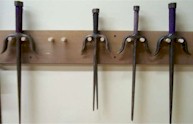![]()

The roots of Traditional Karate lay deep in the history and culture of Asia. Its more recent origins can be traced from the island of Okinawa and then to Japan where it became systematized for modern use. Traditional Karate may be strictly defined as a martial art and as such has distinct characteristics that distinguish it from a purely practical fighting discipline. The underlying principles of Traditional Karate are those of a physical science. As with any science there are basic laws that are integral to its application. The primary intention of training is to mold the movements of the body to accord to these physical laws. The ultimate aim of training is to so deeply imbed the correct mechanics of movement that techniques are executed without conscious effort. Years of repetition and analysis forge the body into an instrument of offensive and defensive potential. Karate training moves from science to art when the aim is directed towards something beyond physical prowess. In Traditional Karate we recognize that to forge the body is also to forge the mind. The practical and philosophical aim of Traditional Karate is to bring the mind and the body together as one. We cannot concentrate the body without concentrating the mind. Conditioning our movements to the correct standards of execution requires sustained concentration of effort and will. To truly develop karate we must call upon our deepest resources. Mastery does not come in a day, a month, or a year. Karate training demands that we overcome discouragement, discipline our emotions in the face of fear, and analyze what it means to commit to a pathway until success is assured. This dedication brings with it a sense of integrity where ethical action and moral certainty naturally evolve within the practitioner. The pathway of inner development that grows from the study of this science is called Karate-do. The literal translation of Karate-do is Empty Hand Way. The meaning implies an attitude of The major systems of Traditional Karate are the libraries of this profound martial culture. The classic karate forms, or kata, encode not only the physical science of movement but also their meaning in self-defense application. Sensei are committed to bringing this information to karate practitioners without compromise. While not all students pass through to the higher levels of traditional training, all ultimately benefit from involvement in a process where standards are clear. Students come to this practice for many reasons. Many have found deeper meaning than originally sought in the training. Far more than a fighting art, Traditional Karate is the study of life. |